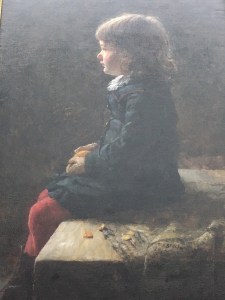
Before

After
I’ve been playing around with a method for improving paintings. My mind is analytical which has some benefits and drawbacks as an artist. Since there is little I can do to change it, I might as well go with it.
After I complete a first draft of a painting I put it on my mantle for a few days. When I’m ready to finish it, I invest time in systematic reflection. I want to have a punch list of changes before I touch paint or brushes. If I don’t, I’ll just waste time mucking around without significant improvement.

I use a notebook. First, I note glaring problems like the shepherd’s crook that needs cleaned up and the birds that aren’t noticeable. I take into account Rich Clem’s advice from our Central Ohio Plein Air group critique -“Get rid of the tree on the right. It doesn’t help the composition.” I want to see if he’s right, so I cover it up. Yes, I think he is! I still want to keep the stump for the bird but I can lose a lot of that tree in shadows and/or foliage.
Then I look for a strong center of interest. When I planned the composition I placed the larger feeder 1/3 of the way down from the top and 1/3 of the way over from the right to be in the sweet spot. It seems to work, but could be strengthened with some subtle tweaks to the background.
The next thing I want to consider is the color scheme. I was painting from nature but I can control how I represent it. This painting uses all of the greens and all of the reds on the color wheel for a complementary color scheme. That’s why the yellow-orange on the smaller feeder looks out of place. I can switch it to red-orange.
Then I work my way through the principles of design: unity, contrast, dominance, repetition (with variation), alternation, balance, harmony and gradation.
Dominance jumps out as a problem. The original painting is about half green. I don’t really have a dominant value either. Even though I did a gray-scale sketch before-hand, I work backwards and do a thumbnail to see where I stand. If I skinny up the tree on the left, I increase the green and the middle values. That also has the advantage of overlapping the small feeder with green foliage instead of framing it within the rectangle of the tree.

Alternation might also be a problem. I could do a better job of connecting the darks.Then I run through the elements of design (line, value, color texture, shape, size, movement) to see if I get any new insights. Just where do the lines lead? I can play with that in the foliage and blossoms. Then I’m ready to work my way through the list to the new and improved painting below.

Reworked Painting
Please leave a comment about my self-critique. What did I miss? Do you have a similar process? I’m keeping the notebook so that I can go back and look for patterns. If you have a process for self-critique I’d love to see it.














